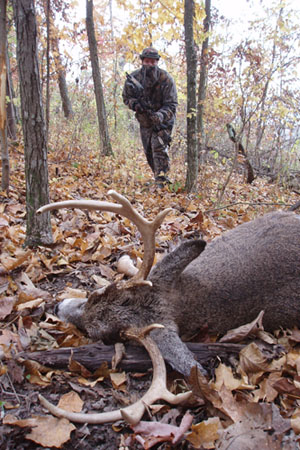 |
| Safe? This buck was taken on the edge of the Wisconsin CWD intensive harvest zone. |
Chronic Wasting Disease Spreading
Three new states have confirmed Chronic Wasting Disease (CWD) inside their borders. A harvested doe tested positive in Frederick County, Virginia. A captive deer in Linn County, Missouri, was confirmed to have the fatal neurological disease. A North Dakota mule deer checked in by a hunter tested positive for CWD in Sioux County. CWD has now been confirmed in 13 states and two Canadian provinces.
Coyotes Alter Deer Management
Through numerous controlled studies, research has proven that coyotes have a major impact on fawn recruitment. In some studies coyotes killed 75 percent of fawns. Because of this, the deer management model for different areas has changed. In areas of high predator populations, shooting a lot of does isn’t necessarily the best protocol because coyotes are taking a large number of fawns from the herd during the summer.
Southern Rut
Did you know: Whitetails are rutting somewhere in the United States from August through February. Amazingly, they breed over this seven-month period just in the state of Florida!
The photoperiod is what sets the rut into motion, but in the South there are so many varying rut periods even though these locations have the same amount of daylight.
In northern regions, photoperiod is more influential in triggering the rut. There is a wider range of daylight lengths from summer to winter in the North than in the southern portions of the U.S. However, climate is a critical factor for fawn survival in the North, so the rut must happen at a precise time to ensure fawns are born with enough time to gain weight prior to the next winter.
In the South, climate is not as much of an issue, so genetic factors contribute to triggering the rut as well as photoperiod. This can create long, drawn-out rutting activity, but if a deer herd is managed well and there is a close buck/doe ratio, the rut can be more intense and concise.
Venison Donations
The top five states in venison donation (in pounds) during the 2009-2010 hunting season include Virginia, Iowa, Missouri, Wisconsin, and Texas. There is no correlation with the total poundage of donated venison and a state’s deer density; rather it appears to be a function of the number and availability of venison programs in each state.
How’d They Do That—Shed Antlers?
How is it that a buck can use its antlers to fight like mad during the fall without losing its rack, but in late winter the same antlers fall off by simply brushing up against something?
A special type of bone cell called an osteoclast removes the bone tissue by reabsorbing calcium between the antler and pedicle (portion of the skull from where the antler grows), and the antler falls off. Bucks occasionally shed both antlers within minutes but more commonly carry one for a few more hours or days. A drop in testosterone in late winter causes this.
Mature Buck—Why All The Fuss?
As hunters, we naturally want to shoot big bucks or mature bucks. However, managing for more mature bucks can have a greater benefit to the deer than the hunter.
1. Studies show that mature bucks help start the rut with pheromones that only mature bucks possess.
2. Mature bucks suppress breeding and rutting activity of young bucks. This protects yearling bucks from losing a lot of weight during the rut prior to winter when they’ll need the extra weight to survive. In the South, mature bucks do the majority of the breeding in the first estrus cycle, whereas yearling bucks would usually take two to three cycles to breed all the does. This would put those fawns being born later in the season at a distinct disadvantage with predation and habitat consumption.
3. Mature bucks keep hunter enthusiasm up. Hunters want to hunt more and longer when mature bucks are captured on trail cameras and seen while hunting.
For more information on the QDMA, visit www.qdma.com.






